Do Consumers Have Trust in Influencers? Here’s What Statistics Show

Updated March 11, 2025
Love them or hate them, if you’re on the internet, you can’t avoid social media influencers.
Influencers have become integral to many social marketing strategies as businesses shift more resources toward digital. While this can create new sales and marketing opportunities, heavily relying on social media isn’t risk-free. Businesses lose ownership over their contacts with a social-first strategy, and the extent to which consumers trust social media influencers fluctuates.
That’s why it’s important to constantly reassess social content performance, while creating a strategy to develop engagement through additional channels.
Here’s what our survey revealed about the way consumers currently view social media influencers and their impact on social media marketing.
The Rise of Influencer Marketing
Influencer Marketing Spend is Increasing
As influencer marketing continues to gain popularity, brands are significantly increasing their influencer marketing spend. A recent survey found that 71% of marketers plan to increase their influencer marketing budget in the next year, with 45% planning to increase their budget by more than 20%. This surge in spending is driven by the growing recognition of the effectiveness of influencer marketing in reaching and engaging with target audiences. As influencer marketing continues to evolve, brands are likely to allocate even more resources to influencer marketing campaigns to maximize their reach and impact.
Key takeaways on social media influencers:
- Operating with authenticity: A majority of Gen Z respondents (31.69%) said Instagram has the most genuine influencers, followed by TikTok (28.67%). A majority of Boomers (31%) said Facebook. One in three respondents said too many sponsored posts are the number one reasons they lose trust in influencers.
- Owning the conversation: As marketers strive to gain direct ownership of their contacts, texting is emerging as a popular choice. A majority of Gen Z (45.07%) said mass text messaging is the number one way they’d prefer to communicate with an influencer outside of social media. Millennials said blog posts were their top choice, while Boomers indicated email was best.
- Influencing purchase decisions with reviews: Understanding consumer behavior is crucial, as influencers significantly affect purchasing decisions and brand loyalty. Most respondents (38%) said reviews are the most helpful social media content, which makes sense when you consider that a majority of online shoppers (52%) said reading online reviews is the number one way they conduct research before buying. A majority (34%) also said unbiased reviews are the best way for influencers to win their trust. Gen Z women are a notable exception to this trend (more on that later).
- Increasing daily posts: One out of three respondents said they would prefer to see content from an influencer they follow several times per day.
- Driving sales and providing value: Nearly 40% of survey respondents said feeling like they “need” the product promoted by an influencer is the most likely way to convince them to purchase.
Generations vary on trusted platforms, but unite against sponsored posts
Before you start investing in a platform because you think it’s perceived as authentic, remember that not all social media users have the same perception of genuine social media content. Being a brand with an authentic mission helps, but so does the channel where your content lives. Survey results showed Gen Z respondents (ages 16 to 24) ranked Instagram as the most trustworthy platform, followed by TikTok. Facebook, which ranked first in all other age groups, was fourth for Gen Z.
These stats prove that perceptions of social media are volatile. Your target audience could have wildly different ideas on what makes authentic content depending on their generation. That’s why it’s important to own your contacts instead of relying solely on social media audiences. Unless you build out text or email lists for your customers, you won’t have a way of engaging them if one platform loses its sense of authenticity in your target age group.
Interestingly, age groups are united by universal distrust for sponsored posts. One in three respondents said too many sponsored posts erode their trust in an influencer. For brands and personalities who rely on sponsored posts to pay the bills, this could represent an issue— how do you provide value while asking for something in return? The answer is to bring audiences deeper into your ecosystem through a variety of touchpoints such as email, business SMS, and direct messages. This enables you to create more meaningful connections and open additional sales channels so sponsored posts become less of a necessity.
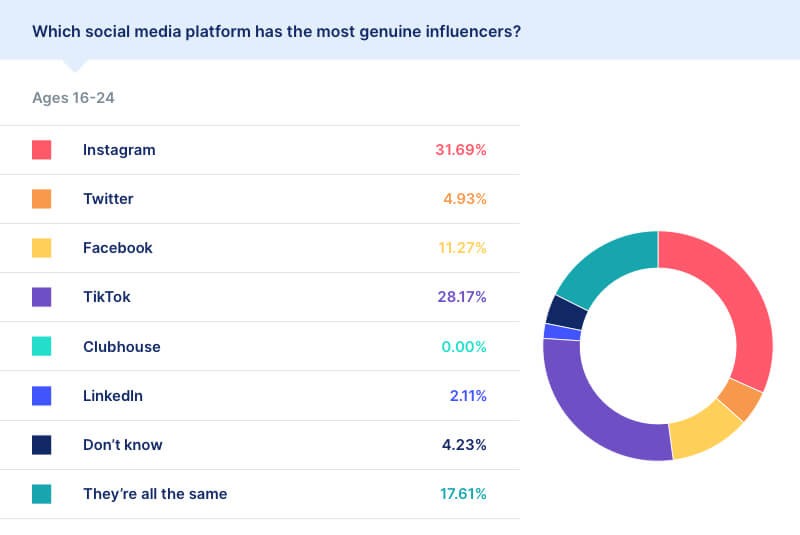
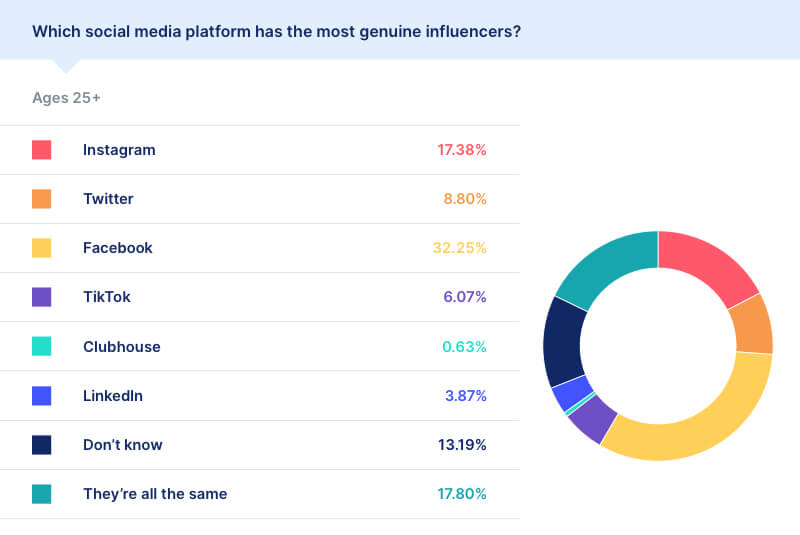
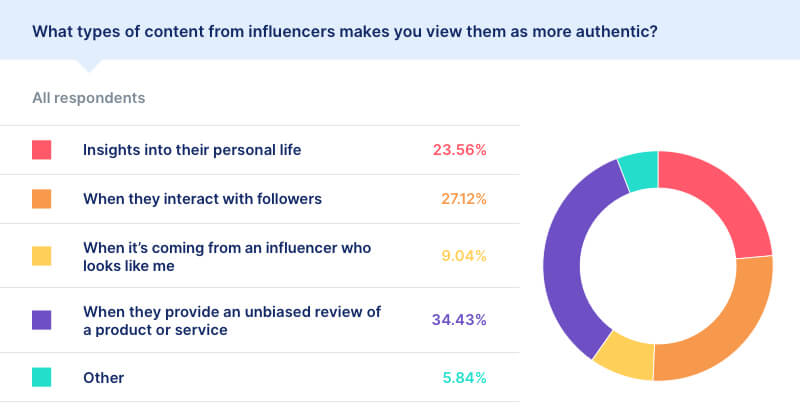
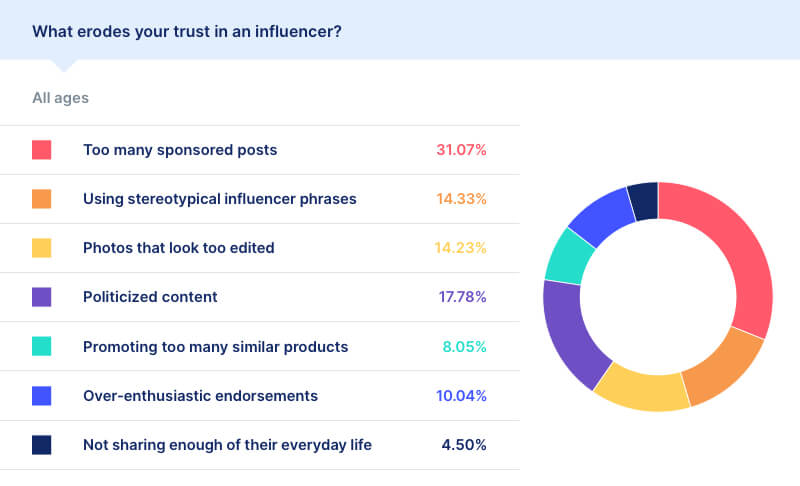
Owning the conversation
Moving your audience into your brand ecosystem sounds nice in practice, but how is it achieved? Again, it depends on the age group you’re targeting. Respondents to our survey ages 16 to 24 ranked text messages as the #1 way they’d like to hear from influencers outside of social media. Blog posts came in second and email in third.
Influencer partnerships can play a crucial role in moving your audience into your brand ecosystem by creating more meaningful connections.
Young Millennials, in the 25 to 34 age range, ranked blog posts as their #1 preference, while older Millennials, Gen Xers, and Boomers ranked email as their top choice.
While your audience might favor one method over another depending on their demographics, a smart marketing strategy will include using all channels at your disposal to create many touchpoints with your customers throughout their journey. Remember, if the content is valuable, your audience will want to hear from you often. You don’t have to do this manually. You can use a mass texting service to stay in touch while maximizing employee resources.
Our customer, Sane Solution, used a version of this strategy to improve their SMS text marketing. Since they already had an incredibly responsive email campaign strategy, they chose the highest-performing emails to reuse as text messages. They found that it was possible to send the same person an email and a text message with similar content if that customer had meaningfully engaged with the content. This case study digs deeper into how they accomplished this.
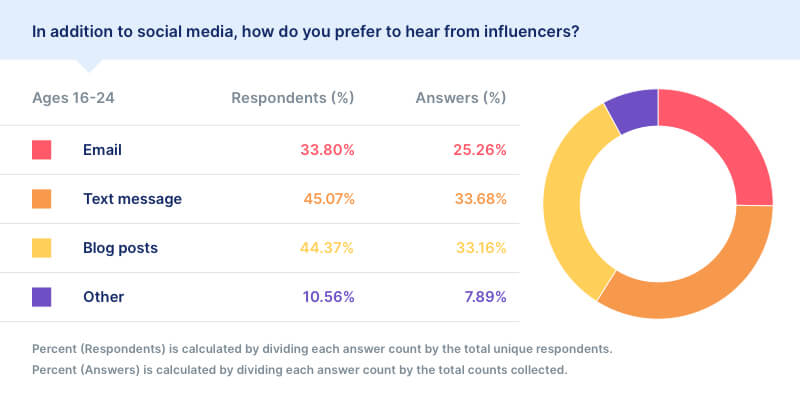

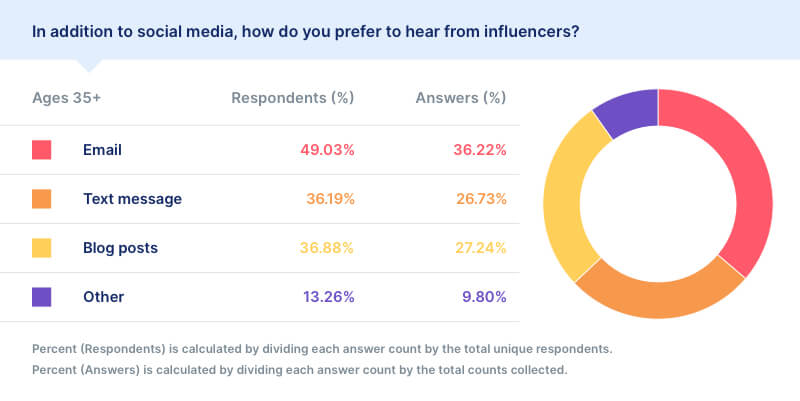
1 in 2 buyers rely on reviews when online shopping
Did you know that 93% of customers read online reviews before making a purchase? Influencer content, particularly when it includes authentic and unbiased reviews, is highly valued by consumers. One of the simplest ways influencers can add value to their followers is by providing unbiased reviews. In fact, 38% of respondents indicated this was the content they found most helpful. This preference held true for every age group except Gen Z women. For Gen Z women, 23% said how-tos are most valuable, followed by motivational posts. And while 34% of overall respondents said the best way to win their trust is with unbiased reviews, Gen Z women differed. 40% of Gen Z women said the best way to win their trust is by interacting with followers.
Authentic reviews aren’t just important for building trust; they’re the main way online shoppers make purchase decisions. One out of two respondents prefers to research using online reviews. As more companies pivot to exclusively digital sales channels, reviews are taking the place of touching and feeling a product before purchasing. Consumers can’t always tell how a product will work by simply seeing photos or videos, so hearing how real people use it has started to become essential. Influencers can help guide this process.
Building Consumer Trust
Building consumer trust is a critical aspect of influencer marketing. Consumers are more likely to trust recommendations from influencers they know and respect, rather than traditional celebrities. According to a recent survey, 69% of consumers trust influencer recommendations, compared to 45% who trust celebrity endorsements. This trust is built on the perceived authenticity and relatability of influencers, who often share personal stories and experiences that resonate with their audience.
Consumers Trust Influencers More Than Celebrities
Consumers trust influencers more than celebrities because they perceive influencers as more relatable and authentic. Influencers often share personal stories and experiences, which helps to build a connection with their audience. Additionally, influencers are often seen as experts in their niche, which adds to their credibility. According to a recent survey, 62% of consumers prefer to follow influencers who are experts in their niche, rather than celebrities. This preference highlights the importance of authenticity and expertise in building trust with consumers.
How to build a strong influencer marketing strategy
If you’re already working with influencers to promote your product, consider emphasizing reviews instead of purely sponsored posts when you create your campaigns. Emphasizing honest reviews can significantly enhance your brand’s credibility among consumers. Give influencers the leeway to be able to provide an honest review of your product, carefully considering both the pros and cons for their audience. Working with an influencer agency could help you create a more meaningful partnership for both sides.
If you’re struggling to obtain reviews or don’t have the budget to work with influencers, turn your customers into your reviewers and leverage their experiences for your social media. You can send them an automatic text message after they’ve used your product or service. Ask them to leave a review on any of your third party review sites or provide feedback directly to you. Then, create graphics or videos from their reviews to use across your social media channels.
For influencers, these survey results underscore the importance of coming across as impartial during reviews. Although brands might have difficulty understanding why your content needs to include both pros and cons, seeing the statistics from this survey could be helpful. Consumers have come to question traditional media and carry a level of skepticism into their relationship with influencers. That’s why it’s important to build trust through honesty.

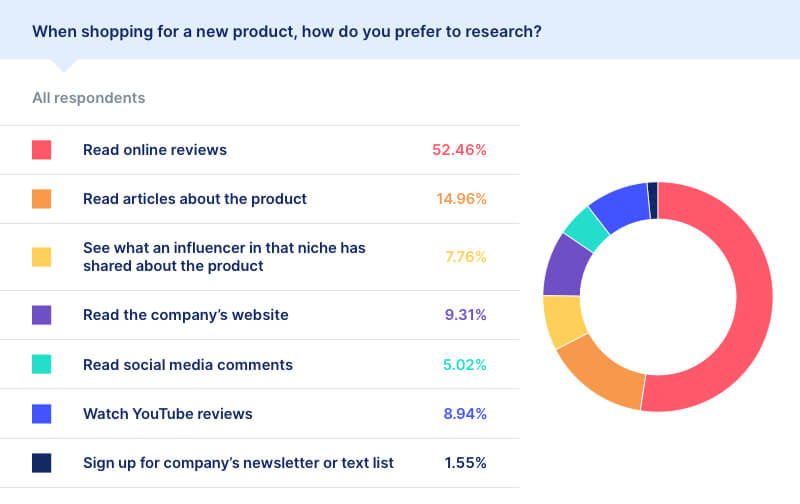
How often can you post?
It’s hard to find the sweet spot between giving your audience what they want and not inundating them with content. While survey respondents indicated that too many sponsored posts erode their trust, they’re still open to hearing from influencers regularly. One in two respondents said they would like to see content from influencers they follow at least once a day, with one in three respondents saying they’d prefer to see content multiple times a day.
Not all of this content has to be concentrated on the same social media platform. It’s smart to diversify the channels you’re active on, particularly as you look toward owning your contacts by transitioning them to email and text lists. Utilizing an influencer marketing hub can help you track engagement rates and optimize your posting strategy across various platforms.
The key to consistently engaging your audience with each touchpoint is to provide real, actionable value such as text sweepstakes. Keep your selling to a minimum, knowing that the more you give to your audience, the more you will ultimately receive in return.

Provide real value
We’ve talked a lot about providing real value— but what is it, and why is that so important? The financial impact of the pandemic and the resulting inflation concerns have caused consumers to prioritize value in their purchase decisions. We asked, “What makes you more likely to purchase a product an influencer has promoted?” Nearly 40% of respondents said, “If I need that specific product.” But this mentality doesn’t stop simply at purchasing products— the same can be said for what motivates people to interact with a post, sign up for another communication form, or even open text messages from you.
According to a recent influencer marketing report, understanding current trends and insights is essential for crafting impactful marketing strategies.
Your audience needs to feel like they need what you’re offering. That’s why so many of our customers have seen success using broadcast messaging and SMS loyalty rewards— there’s real value in signing up for the text list. It’s also why audiences like reviews or how-to videos. These pieces of content offer actionable takeaways, and they’re essential to crafting an impactful marketing strategy in 2025.

The Future of Influencer Marketing
As influencer marketing continues to evolve, it’s clear that the future of influencer marketing is bright. With the rise of new social media platforms and the increasing importance of authenticity and transparency, influencer marketing is becoming a key aspect of digital marketing. Brands are increasingly recognizing the value of partnering with influencers to reach and engage with their target audience in a more authentic and meaningful way.
Gen Z Values Interactive and Authentic Content
Gen Z values interactive and authentic content, and influencer marketing is well-positioned to deliver this. According to a recent survey, 70% of Gen Z consumers prefer to follow influencers who create interactive content, such as polls and quizzes. Additionally, 65% of Gen Z consumers prefer to follow influencers who are authentic and transparent in their content. As Gen Z becomes a larger part of the consumer market, influencer marketing will need to adapt to meet their needs and preferences.
Influencer marketing is a powerful tool for brands to reach and engage with their target audience. By partnering with influencers who have built trust and credibility with their audience, brands can increase brand awareness, drive website traffic, and generate sales. As the influencer marketing landscape continues to evolve, it’s clear that influencer marketing will remain a key aspect of digital marketing for years to come.
Bottom line
Because consumers are placing an increased importance on reviews when online shopping, content from social media influencers is becoming more useful for businesses looking to influence purchase decisions online. While traditional celebrities have long been used in marketing, the appeal of celebrity influencers has waned as consumers seek more relatable and authentic personalities. Yet the relationship between influencers and their audiences is only as valuable as the amount of trust consumers have for the influencers they follow. There are many factors that could impact this trust, everything from the platform itself to how often influencers are posting. While an informed strategy is needed to optimize trust, marketers should also be keenly aware of the volatile nature of social media and constantly work to own their lists so they can adjust to rapid changes. Check out our SMS marketing best practices page to see how to own your lists in an ethical and legal manner.
Survey methodology
These results are based on a survey of 1,100 American adults in March 2021.